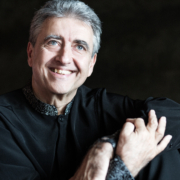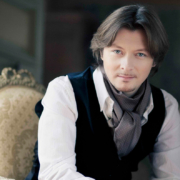Opera singer Szilvia Vörös is the daughter of a family of musicians. She went to a music primary school in her hometown of Ajka, and although there were some detours on her way to bigger and bigger cities and international success, she says everything always had to happen just like and just when it did.
Text: Kriszta Máté
Szilvia Vörös’ personality radiates calmness and also a positive sense of discipline. These are probably the very qualities she may need as an artist at the Vienna Opera to adapt to the daily rehearsal schedule and the strange situation of recent years.
“Refi taught me a system”
My first question is regarding the influence of the Calvinist grammar school in Pápa as her first station away from his parents’ house and the security of home. I wonder if it had anything to do with the discipline that is so tangible in her. She says thoughtfully that, interestingly, she doesn’t feel particularly disciplined, but the Grammar School of Pápa Reformed College – “Refi”, as insiders say (short form of “reformed” which is the colloquial name of the Calvinist Church and denomination in Hungary – the tr.) – certainly taught her a system to follow.
“It was a strict school, we had to attend on Saturdays, too, but thanks to the so-called cycle system at the time, the weekend classes accumulated over 4-5 weeks were later compensated by a one-week break.”
Being away from home was very difficult at first. The fact that she persisted was thanks to her mother, who always encouraged her not to give up so easily. It might have been a challenge at first, but looking back it was definitely worth it and lifelong friendships were formed.
But how did she get from Ajka to the Calvinist Grammar School in Pápa? The answer is a funny story: “My father was a trumpet and flute teacher and the conductor of the brass band in Ajka. He once took one of his pupils to a trumpet competition, where he met a boy from an advanced trumpet course who enthusiastically told him about Refi and how he enjoyed being a student there. Later, we heard some good things about the school from other people we knew, and as I had no specific plans for further studies, I took the written and oral admission exams. And I got in.”
During high school, music classes receded into the background for a while; just one private singing lesson a week – after the usual weekly dose of four singing lessons, two solfège lessons, two piano lessons and choir practices back in the music primary school. After the first year, however, she felt the desire to sing again and started studying with a private singing teacher, Ágota Eisenbeck. With her guidance and help, she became more and more confident in music. She could have gone to secondary school to the Győr Conservatory to study music theory and solfège. (Her mother is also a music teacher, piano and solfège, so it would have been a very obvious choice.) “But back then I decided to go to the grammar school, because I thought why teach something that every child hates? Of course, the Calvinist grammar school seems to be a bit of a detour, because afterwards I ended up in Győr, albeit at a solo singing course under Veronika Dobi-Kiss’ wing. I studied there for a year and a half, and then I was accepted to the University of Art in Graz for a so-called cross-semester course, and eventually spent half a year there.”
“Éva Marton was in for a surprise, too”
“The ‘coincidences’ of my life were revealed in Graz, too; the power of Providence that eventually brought me to the Music Academy. If I had stayed in Hungary, I certainly would not have started as a university student in 2008, as I did not apply for higher education. But it was in that year that I won the first category of the Simándy József International Singing Competition, where Éva Marton noticed me and asked me to apply to the Liszt Academy. As both universities were already operating under the Bologna system at the time, I was able to transfer from Graz to Budapest despite not having submitted an application form.”
Then came the big city life, which she had to get used to: the hustle and bustle, everyone in a hurry, everything moving so fast. She studied in Éva Marton’s class, where she also did pretty well. “Éva Marton is a strict teacher, she has an atmosphere of her own, but if you make efforts and do well, you can develop a very good relationship with her.” It was during her studies at the Music Academy that it she realised: this was clearly and definitely her path to follow. To my question about when exactly she realised that this was something that could allow her to give, something she had to embrace, she said: “I think I’m a person who builds up slowly, I need more time to not have that tense frenzy in me, but to be able to convey the feelings and messages associated with a musical role. And have fun at the same time. The stage has done good to me, and eventually I got used to stage fright. Thus, when I sang Kodály’s Nausikaa at the first-year student concert, Éva Marton herself was surprised, because previously, in class, I had not been able to show everything I had in me that, however, managed to come through in my performance at the concert. It was there that Nausikaa was born in me.”
We talk a little about the development of voice, and when she found out what voice parts and corresponding roles she would be singing. “Your voice register starts to emerge after mutation, but you have to start carefully in working out the voice type! It’s very important that one’s character is also a determining factor in one’s suitability for a role. You have to be able to separate the desires from the person. I, for example, am a great fan of Puccini’s Liù from Turandot or the soprano aria Quia respexit from Bach’s Magnificat, but it is not enough to like the melody and want to be part of a performance. Of course, you need a teacher to help you assess and dig up your talents, and to give you signposts along the way, so that in time you can stand on your own two feet.” But let’s go back to the Music Academy! It was an unexpected turn that brought her there, and it was in a similar way that the Vienna Opera came into her life. It was not a long cherished dream of hers.
“The capacity for progress”
In 2014, Szilvia won the 1st Éva Marton International Singing Competition. “It was a huge and inspiring milestone in my life. When you are praised and constantly receive good feedback, it can give you strength and confidence. But for a healthy self-awareness, we also need criticism that points out our mistakes and shortcomings, because I believe that it is through them that we can improve. Throughout my life, I have had and continue to have people who teach me, guide me and give me feedback, people I trust unconditionally and value their comments. For that I am extremely grateful to them. After the Marton Competition, I had the feeling that I had achieved a great success, that this was an important step in my career. At the same time, I had never sung anywhere outside Hungary. And this country is small and the music scene is quite limited. I had a strange, dissonant feeling, and I felt – to use a not too nice image – that every little cock could be master of its own heap. To be able to grow and change, first we must first know ourselves.
So I started my search to find out where I was at the time, where it would be worth to go next. This is one of the reasons why I applied for master classes and singing competitions. And another story to prove that failures do happen for a reason: in the 2015 Neue Stimmen auditions, 42 people were selected from around the world for the live rounds in Germany. I wasn’t in the best state of mind or voice at the time, so I didn’t make it through the first round. But it turned out that ranking wasn’t the main point. Since it was possible to ask the jury members for feedback, I took the opportunity to contact Evamaria Wieser, who was the head of the Young Singers project at the Salzburg Festival. Even though I didn’t perform to the best of my ability, she heard something in my voice and suggested I go to the audition in Salzburg. At that audition, I performed exceptionally well and was given the opportunity to participate in the 2016 Young Artist Programme.”
At that point, she had been a private singer at the Hungarian State Opera for two years, since 2014, where she spent four years before being contracted by the Vienna Opera for the 2018/2019 season. As by now she has spent similar periods of time in both operas, I ask her to compare the two institutions. “In Budapest, singers have been working as freelance singers since the early 2000s, but in Vienna there is a company. At home, we sign up for roles, which gives us a bit more freedom to decide what we say yes to and what we say no to. But of course, you also have to be lucky to be asked. In Vienna, we are given a lot of tasks in the company, not only to learn the roles that I’m going on stage with, so my name is in the cast, but as a company member, in case my colleague in the play can’t be there for illness or other reasons, I have to be ready to jump in. This is called ‘covering’. That is, I prepare and learn both the role and the direction. It’s a more complex task, and the singer is also a little more vulnerable because of the obligatory roles he or she has to take on. Of course, there is room for dialogue, if one can give a good reason why one does not want to/can’t sing the role in question. But in return, there is a fixed salary, whereas as a freelancer you get paid for the roles you actually sing.” The difference between the two opera houses is that while the Hungarian State Opera works mainly with Hungarian singers, the Staatsoper has a very diverse company, with some big names from all over the world singing the main roles night after night.
I have colleagues from Australia, Mexico and Russia, but I have also worked with fellow singers from South Korea, China and South Africa.
Just a frill or real magic?
There is no getting around the question of the two-year-long epidemic measures; what it was like to live alone in Vienna, away from the family, with the opera house closed. “I had friends who sang in the choir and went home for Easter, but couldn’t return because the borders had been closed. Frankly speaking, for me the first period of covid was liberating, both because it suddenly cut an end to a terribly busy and exhausting period (from mid-January to the end of March I had 9 roles to prepare for and/or sing on stage) and although I was left alone in Vienna, I could dedicate time to what I loved doing. It was a good period of self-discovery: I started painting with acrylics, it was spring, the sun was shining, I went for walks and hikes. Of course I practised and learned my roles, too, and in June the rehearsals re-started. We could give concerts with piano accompaniment to an audience of 100 people. This second phase was harder, as the last time I had sung on stage was in February. After that, there were concerts in the summer, but in the new season I only did covering in September and October. My next performance was on 4 November, but by then another lockdown period was starting. So I was off the stage for eight months, it was all quite hopeless, winter came, it was difficult. Fortunately, from December onwards, the opera switched to online performances, so from the next January I was actively rehearsing for Nabucco and Carmen. We rehearsed Carmen for 6 weeks, as it was a première at the Staatsoper. By the way, this Calixto Bieito production has been running successfully for over 20 years. It is extremely rough and intense, so Mercedes’ character didn’t sell easily for me at the beginning, but it was worth every effort to work with it. I don’t like to separate performances into modern and traditional productions. I think there are good and bad productions. And it doesn’t matter what costumes or sets are used to stage the play, both can be spoiled if the director doesn’t give meaning to the connections. If you can build up the play well, so that there is a framework to give it direction from beginning to end, if there are concrete relationships and characters, you can make a very good production even with a minimal or modern set. In Carmen, the scene changes were so subtle, so well proportioned, that even without an audience, our streamed performance had fantastic energy. The long rehearsal process also helped us tune in with each other and the play. This feat, perhaps because of the new protagonists and the shorter rehearsal period, could not be repeated later in the May/June performances, which were already in front of the audience.”
The question arises about audiences: is there any place in the world where there is a really good audience, is there a favourite one? As she sees it, the place almost doesn’t matter at all, it’s just the spirit and mood of the audience that always also sits in the room. If there is no capacity to receive, then it’s almost irrelevant what kind of energy is at work on stage. Of course, each production also requires preparation on the part of the performers. Along with the music and the direction, if there is no desire to communicate, and if we fail to evoke the right emotions, or do not get psyched up for the performance, then it is difficult to create real theatre. However, if both the receiver and the performer are active in their “roles”, then the channel is created and this dynamic will give the evening its quality, its dialogue. It would be foolish to think that this can be repeated every time, but the effort will bring around the much longed-for opportunity with time. “When a performance goes very well, it is said that an angel has passed over the stage. I was incredibly lucky, because when I played the role of Anna in Berlioz’s grand opera in Vienna in my first season, the entire cast and audience had a cathartic experience at the public rehearsal. It’s rare to have this kind of interweaving, but that’s what makes it beautiful.”
How interesting that a streamed performance without an audience can give the cast a cathartic experience, like the aforementioned Carmen, even though the cast may feel as if they are singing to themselves. “I was just talking to a friend the other day about how I have felt useless several times in the last two years, and I’ve been wondering seriously what happens when what I do no longer has a raison d’être in the 21st century, how much it is still considered a frill, a luxury item – or, more in general, how important culture itself is. I was somewhat reassured by her answer, and even if the question itself does arise, humanity will always have a need for culture. It can be incredibly rewarding to be able to go to the theatre or the opera and shut out the outside world for two or three hours and be completely enchanted by and in another world.”












